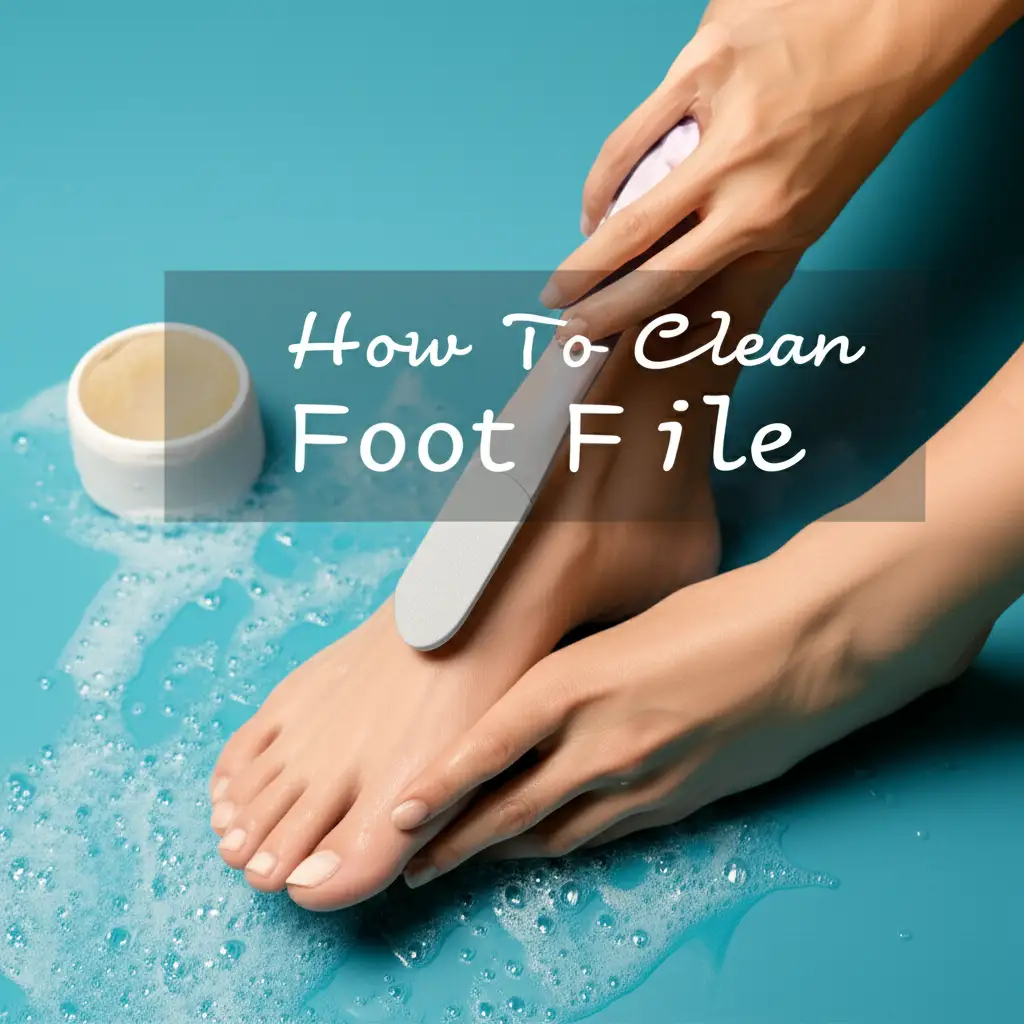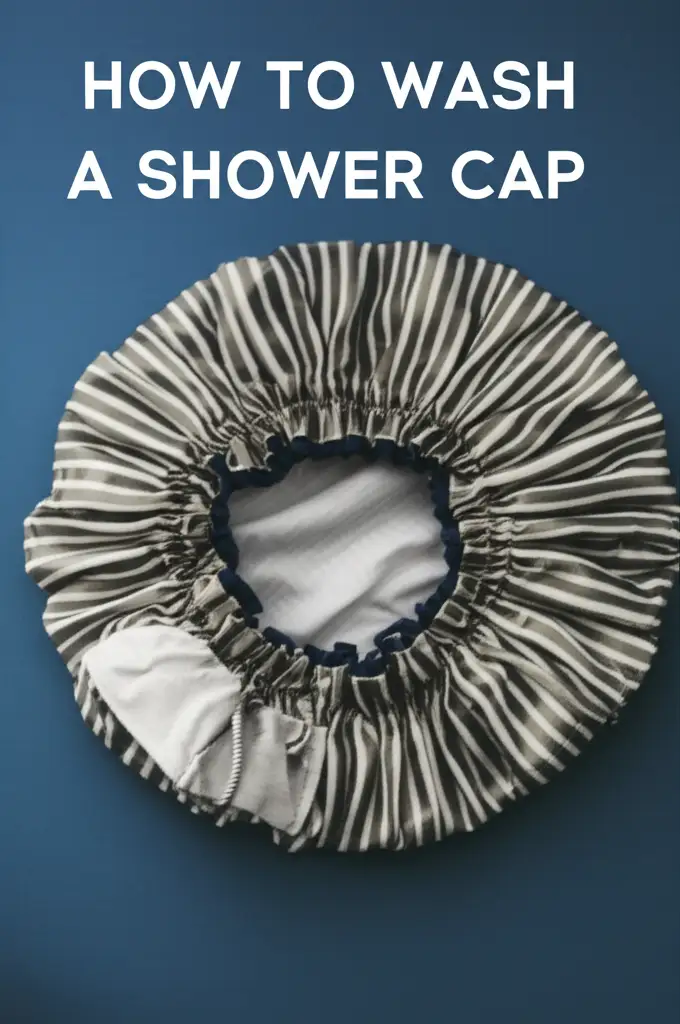· Foot Care, Hygiene, Cleaning Tips · 19 min read
How To Clean Foot File

Clean Your Foot File: A Step-by-Step Guide
Keeping your feet smooth and soft often involves using a foot file. This handy tool helps remove rough, dead skin and calluses, making your feet feel much better. However, a foot file collects a lot of skin cells and debris with each use. This buildup is not just unsightly; it can harbor bacteria and fungi. Learning how to clean your foot file properly is essential for your foot health and the tool’s longevity. A clean foot file works better and keeps your feet safe from infections.
In this article, we will explore why cleaning your foot file matters. We will cover the supplies you need and provide step-by-step instructions for cleaning different types of foot files. We will also discuss disinfection, drying, and storage methods. Following these steps ensures your foot care routine is effective and hygienic.
Takeaway
- Regularly clean your foot file after each use to remove skin debris.
- Disinfect your foot file weekly or after every few uses to kill bacteria.
- Use a brush, soap, and water for basic cleaning.
- For disinfection, soak in rubbing alcohol, bleach solution, or a professional disinfectant.
- Dry your foot file completely before storing to prevent mold and mildew.
A foot file collects dead skin cells and bacteria after each use. To clean a foot file, first rinse it under warm water to remove loose debris. Then, scrub it with a stiff brush and soap to dislodge stuck particles. Finally, disinfect the file by soaking it in rubbing alcohol or a bleach solution before allowing it to air dry completely.
Why Cleaning Your Foot File Matters for Foot Health
Using a foot file is great for achieving smooth feet. Yet, many people overlook the importance of cleaning these tools. A foot file gathers dead skin cells, dirt, and moisture. This creates a perfect breeding ground for bacteria, fungi, and other microorganisms. These germs can cause serious foot problems if they transfer back to your skin.
Imagine using a dirty file on a small cut or abrasion on your foot. This could lead to infections, athlete’s foot, or fungal nail issues. Proper foot file cleaning is a simple yet crucial step to prevent such problems. It keeps your feet healthy and safe. This practice is part of good personal hygiene, much like cleaning your toothbrush or nail clippers.
Beyond health, cleaning extends the life of your foot file. When debris clogs the abrasive surface, the file becomes less effective. You have to work harder to remove dead skin. Regular cleaning ensures the file performs at its best. It keeps the abrasive surface sharp and clear. This saves you money in the long run by not needing to replace your tools as often. Always prioritize cleanliness for both your well-being and your tools.
Essential Supplies for Effective Foot File Cleaning
Before you begin cleaning your foot file, gather the necessary supplies. Having everything ready makes the process smoother and more efficient. You likely already own most of these items, or they are easy to find. Proper tools help ensure thorough pedicure tools cleaning.
Here is a list of essential items you will need:
- Warm Water: This helps loosen and rinse away skin debris.
- Liquid Soap: Dish soap or antibacterial hand soap works well. It cuts through grime and helps sanitize.
- Small Stiff Brush: An old toothbrush, a nail brush, or a specialized cleaning brush is perfect. It helps dislodge stubborn skin particles from the file’s surface.
- Disinfectant (Optional but Recommended):
- Rubbing Alcohol (70% isopropyl alcohol): This is a good option for most foot files. It effectively kills many bacteria and viruses.
- Bleach Solution: Mix one part bleach with ten parts water. Use this cautiously and rinse thoroughly afterward. It is a powerful disinfectant.
- Commercial Disinfectant Spray: Many beauty supply stores sell disinfectants for salon tools. Look for ones labeled as bactericidal, fungicidal, and virucidal.
- Clean Towel or Paper Towels: For drying the foot file after cleaning.
- Protective Gloves: Recommended when handling bleach or strong disinfectants to protect your hands.
Having these supplies on hand ensures you can clean and sanitize your foot file completely. This prepares it for safe future use. It protects your foot health.
Step-by-Step Guide to Deep Cleaning Your Manual Foot File
Deep cleaning your manual foot file ensures it remains hygienic and effective. This process involves more than just a quick rinse. It removes all trapped skin and kills harmful germs. I always do this after every use, or at least once a week if I use it frequently.
Here are the steps to deep clean your foot file:
Initial Rinse and Debris Removal
First, hold your foot file under warm running water. This helps loosen and wash away the bulk of the dead skin cells. You will see a lot of the white powdery residue disappear quickly. For persistent debris, gently tap the file against a hard surface, like the edge of a sink, to dislodge any larger pieces caught in the grates or abrasive surface. This initial step is simple but very important.
Scrubbing with Soap and Brush
Next, apply a few drops of liquid soap directly onto the foot file. Use your small stiff brush to scrub the entire surface. Pay close attention to the textured areas where dead skin tends to accumulate. For metal files, scrub between the tiny teeth. For pumice stones or sandpaper-like files, scrub vigorously to penetrate the porous surface. This physical scrubbing action, combined with soap, removes deeply embedded particles. It helps break down any oils or residues left on the file. Rinse the brush as needed to keep it clear of debris. This step makes a significant difference in cleaning effectiveness.
Disinfection Process
After scrubbing, it is time to disinfect. This step is crucial for killing bacteria and fungi. You have several options for disinfection:
- Rubbing Alcohol Soak: Pour 70% isopropyl alcohol into a shallow dish. Submerge your foot file completely for at least 5-10 minutes. Alcohol evaporates quickly and is effective for many types of foot files.
- Bleach Solution Soak: Mix one part household bleach with ten parts water in a basin. Submerge the foot file for 5 minutes. Warning: Bleach is strong. Wear gloves and ensure good ventilation. Rinse the file extremely well with clean water after soaking to remove all bleach residue. This strong disinfectant is excellent for eliminating mold, similar to how one might tackle mold in a shower, as detailed in articles like how to clean mold in shower.
- Commercial Disinfectant: Follow the instructions on the product label. These are often sprays or soaks designed for salon tools. They are usually effective and safe for various materials.
Regardless of the method chosen, ensure the entire abrasive surface is covered by the disinfectant. This ensures maximum germ-killing power.
Final Rinse and Drying
After disinfection, rinse your foot file thoroughly under warm running water again. Make sure to remove all traces of soap or disinfectant, especially if you used bleach. Residual cleaning agents can irritate your skin or damage the file over time. Finally, pat the file dry with a clean towel. Then, allow it to air dry completely in an open, well-ventilated area before storing it. Proper drying prevents rust, mold, and mildew growth. This step is just as important as the cleaning itself.
Cleaning Electric Foot Files: Special Considerations
Electric foot files offer convenience, but they require a different approach to cleaning compared to manual ones. These devices often have removable abrasive heads or rollers. Cleaning them incorrectly can damage the electronic components. Always check your specific model’s instruction manual first. The manufacturer provides the best cleaning guidance for your device.
Most electric foot files are not designed to be fully submerged in water. This means you must clean them carefully. The main focus is on the detachable roller or disc. This is the part that touches your skin and collects dead skin.
Here is how to clean an electric foot file:
Detach and Clean the Roller Head
First, turn off and unplug the electric foot file. Then, carefully remove the abrasive roller or disc according to your model’s instructions. Some rollers click off easily, others might twist. Once detached, you can clean this part separately. Hold the roller under warm running water to rinse away loose skin debris. Use a small, stiff brush, like an old toothbrush, to gently scrub the roller. Apply a small amount of liquid soap to the brush. Scrub all surfaces of the roller to remove embedded skin particles. Rinse the roller thoroughly under clean water.
Clean the Device Body
The main body of the electric foot file, which contains the motor and battery, should only be wiped down. Use a damp cloth to clean the exterior of the device. You can add a drop of mild soap to the cloth if needed. Never submerge the body in water. Water can damage the electronics. Ensure the cloth is only damp, not dripping wet. If your device has a dust collection chamber, empty it after each use. Wipe it clean with a dry or slightly damp cloth.
Disinfecting Electric Foot File Components
Disinfecting is important for electric foot files too. After cleaning the roller head with soap and water, you can disinfect it. Spray the roller head with 70% isopropyl alcohol. Let it sit for a few minutes to kill germs. Alternatively, you can soak the roller head in rubbing alcohol for about 5 minutes if it is fully waterproof. For the main body, you can use an alcohol wipe or a cloth lightly dampened with disinfectant spray. Do not spray disinfectant directly onto the body, as it might seep into crevices and damage components. Allow all parts to air dry completely before reassembling. This ensures no moisture is trapped inside the device.
Disinfecting Your Foot File: Beyond Basic Cleaning
Cleaning removes visible dirt and debris. Disinfection kills the invisible germs that cause infections. This step is critical for maintaining true foot hygiene. While soap and water wash away skin particles, they do not eliminate all bacteria, fungi, and viruses. Disinfecting your foot file regularly prevents the spread of skin conditions. I consider this a non-negotiable step after every few uses or at least once a week.
Here are the most effective ways to disinfect your foot file:
Rubbing Alcohol
Rubbing alcohol, specifically 70% isopropyl alcohol, is a readily available and effective disinfectant. After cleaning your foot file with soap and water, completely submerge it in rubbing alcohol. Let it soak for at least 5 to 10 minutes. Alcohol works by denaturing proteins and dissolving lipids, which destroys the cell walls of many microorganisms. After soaking, remove the file and let it air dry completely. Alcohol evaporates quickly, leaving no residue. This method is safe for most types of foot files, including metal and plastic ones. It is a quick and efficient way to sanitize your tools.
Bleach Solution
A bleach solution is a very powerful disinfectant. It is excellent for killing a wide range of bacteria, viruses, and fungi. To prepare, mix one part household bleach with ten parts water in a basin. For example, use one cup of bleach with ten cups of water. After cleaning your foot file with soap and water, submerge it in the bleach solution for 5 minutes. Always wear gloves when handling bleach. Ensure good ventilation in the area. After 5 minutes, remove the file and rinse it extremely thoroughly under clean, running water. Any remaining bleach residue can irritate your skin. Dry the file completely before storing. This method is effective for general cleaning needs, much like how one might use a vinegar cleaning solution for shower surfaces or even to address more stubborn issues such as mold with vinegar.
Commercial Disinfectants
Many commercial disinfectants are available for salon and personal use. Look for products labeled as “barbicide” or “hospital-grade.” These disinfectants are specifically formulated to kill a broad spectrum of pathogens. Read the product label carefully for specific instructions. Some require soaking, others are sprays. Always follow the recommended contact time. This ensures the disinfectant has enough time to kill germs. These products are often highly effective and safe for a variety of materials, including common plastic tools, similar to how specific cleaners work for plastic shower components. After using a commercial disinfectant, rinse your foot file if the product instructs, and then allow it to air dry fully.
Drying and Storing Your Foot File Properly
Proper drying and storage are just as crucial as the cleaning process itself. Moisture is the enemy of any clean tool. It can lead to rust on metal files or encourage the growth of mold and mildew on porous materials. Incorrect storage can also damage the file’s abrasive surface. This makes it less effective over time.
Here is how to properly dry and store your foot file:
Thorough Drying
After cleaning and disinfecting your foot file, shake off any excess water. Then, use a clean towel or paper towel to pat it dry. Do not just wipe it quickly; really absorb as much moisture as possible. The next step is air drying. Find a spot where air can circulate freely around the file. Do not put it away immediately in a closed drawer or container. Lay it flat on a clean, dry surface, or hang it if your file has a loop. Allow it to air dry for several hours, or even overnight. This ensures every crevice is completely dry. This prevents rust on metal parts and stops mold from growing.
Optimal Storage Practices
Once your foot file is completely dry, proper storage keeps it clean and extends its life. Store your foot file in a clean, dry place. Avoid storing it in damp environments like directly inside the shower or bathtub. These areas often have high humidity, which can promote mold and mildew. A drawer in your bathroom vanity or a cabinet is usually a good choice. Consider storing it in a dedicated, breathable pouch or container. This protects the abrasive surface from damage and keeps it free from dust. For metal files, this prevents dulling. For files like glass nail files, proper storage is equally important to prevent breakage and maintain effectiveness, much like how you would care for a glass nail file. Proper storage ensures your foot file is ready for its next use, clean and effective.
How Often Should You Clean Your Foot File?
The frequency of cleaning your foot file depends on how often you use it and your personal hygiene standards. For optimal health and effectiveness, I follow a simple rule: clean it after every single use. This immediate cleaning prevents skin debris from drying and hardening on the file. It makes future deep cleaning much easier.
Here’s a breakdown of cleaning frequency:
After Every Use
This is the golden rule for basic cleaning. Immediately after you finish using your foot file, rinse it under warm running water. Use a small stiff brush and a little soap to quickly scrub away any visible dead skin. This prevents buildup. If you let skin particles dry on the file, they become much harder to remove later. This quick rinse and scrub takes less than a minute. It is an easy habit to adopt. This regular maintenance ensures your file stays relatively clean between deeper cleaning sessions.
Weekly or After Every Few Uses
Beyond the quick rinse, a more thorough disinfection is necessary. I recommend disinfecting your foot file at least once a week if you use it regularly. If you use it less often, disinfect it after every 2-3 uses. This involves soaking the file in rubbing alcohol, a bleach solution, or a commercial disinfectant, as described in previous sections. This deep cleaning step kills any bacteria or fungi that might have survived the basic rinse. It is especially important if you have any cuts or skin irritations on your feet. Consistent disinfection is a key part of good foot care. It protects your foot health over time.
Special Circumstances
There are times when immediate and thorough disinfection is absolutely essential. If you share your foot file, which I highly discourage, it must be disinfected before and after each use by a different person. If you use your foot file on someone else, immediate and full disinfection is critical. If you or someone in your household has a foot infection, like athlete’s foot or a fungal nail infection, disinfect the file immediately after use. You might even consider discarding the file to prevent re-infection. If your foot file accidentally comes into contact with contaminated surfaces, clean and disinfect it at once. These situations demand extra vigilance to prevent germ spread.
Signs Your Foot File Needs Replacement
Even with the best cleaning and maintenance, foot files do not last forever. Over time, the abrasive surface wears down. It becomes less effective at removing dead skin. Ignoring these signs and continuing to use a worn-out file can actually do more harm than good. A dull file requires more pressure, which can irritate your skin or cause discomfort. Knowing when to replace your foot file is part of a complete dead skin removal routine.
Here are key indicators that it is time to get a new foot file:
Reduced Effectiveness
The most obvious sign is when your foot file simply does not work as well as it used to. If you find yourself applying more pressure, or if it takes longer to remove dead skin, the abrasive surface is likely worn down. A new foot file should feel quite rough and remove skin efficiently with moderate pressure. If your file feels smooth to the touch in areas that should be coarse, its effectiveness is compromised. This means you are no longer getting the exfoliation you need.
Visible Wear and Tear
Inspect your foot file closely. Look for any visible signs of wear and tear. For metal files, the tiny grater-like teeth might become dull, bent, or even break off. For pumice stones, they can become smooth and lose their gritty texture. Sandpaper-style files will show obvious signs of fraying or bald spots where the abrasive material has worn away. Plastic components might crack or chip, and wooden handles can splinter. Any significant damage indicates a need for replacement. These issues can also make the file uncomfortable or unsafe to use.
Persistent Odor or Discoloration
Despite regular cleaning and disinfection, some foot files, especially porous ones like pumice stones, can develop a persistent, unpleasant odor. This smell often indicates deeply embedded bacteria or fungi that are difficult to remove completely. Discoloration, such as dark spots or patches that do not wash off, can also be a sign of mildew or fungal growth within the material. If your foot file smells consistently bad or shows stubborn stains, it is a clear sign that it is time for a new one. It means the sanitation measures are no longer enough.
Hygiene Concerns
If you have used your foot file during a period of foot infection (like athlete’s foot or a particularly stubborn fungal nail infection), even after rigorous cleaning, it is often best to simply replace it. While disinfection helps, microscopic spores or bacteria might remain embedded deep within the material. Replacing the file eliminates any risk of re-infection or spreading the infection to other parts of your foot. Prioritizing callus remover hygiene in such cases is paramount. Your health is more important than extending the life of an old tool.
FAQ Section
Can I put my foot file in the dishwasher?
Generally, no. Most foot files are not dishwasher safe. The high heat can warp plastic components, dull metal grates, or damage adhesive on sandpaper-style files. Electric foot files are definitely not safe for dishwashers due to their electronic parts. Manual washing with soap and a brush is always the recommended cleaning method.
How do I clean a metal foot file?
Clean a metal foot file by rinsing it under warm water. Use a stiff brush and liquid soap to scrub between the grates to remove dead skin. After scrubbing, rinse well. Disinfect by soaking in 70% isopropyl alcohol for 5-10 minutes. Then, air dry completely to prevent rust.
What if my foot file smells bad?
A bad smell often means bacteria or fungi are present despite cleaning. Try a more aggressive disinfection, such as soaking in a bleach solution (1 part bleach to 10 parts water) for 5 minutes, followed by thorough rinsing. If the smell persists, especially with porous files like pumice stones, it is best to replace the foot file.
Is rubbing alcohol good for cleaning foot files?
Yes, rubbing alcohol (70% isopropyl alcohol) is excellent for disinfecting foot files. It kills most bacteria and viruses effectively. After cleaning your foot file with soap and water, submerge it in rubbing alcohol for 5-10 minutes. It evaporates quickly, leaving the file sanitized and ready for use.
How often should I replace my foot file?
Replace your foot file when it shows signs of wear, such as reduced effectiveness or visible dullness. Also replace it if it develops a persistent bad odor or discoloration that cleaning cannot fix. For hygiene reasons, it is also wise to replace it after a severe foot infection. This ensures optimal performance and safety.
Can I share my foot file with others?
No, it is highly recommended not to share foot files. Sharing personal care tools like foot files can easily spread bacteria, fungi, and viruses. Each person should have their own foot file. This practice prevents cross-contamination and maintains good personal hygiene for everyone involved.
Conclusion
Cleaning your foot file is not just about making it look nice. It is a vital step in protecting your foot health and extending the life of your essential pedicure tools. We have explored why proper foot file cleaning prevents the buildup of harmful bacteria and fungi. We also covered the simple supplies you need and provided clear, actionable steps for both manual and electric foot files. Remember, disinfection is key beyond basic washing.
By consistently following these practices – rinsing after every use, deep cleaning weekly, and proper drying and storage – you ensure your feet remain healthy and smooth. Do not underestimate the power of a clean tool. Prioritize your foot hygiene. Take action today by cleaning your foot file with confidence. Your feet will thank you for the care.
- foot file cleaning
- pedicure tools
- foot hygiene
- dead skin removal
- personal care
- callus remover




